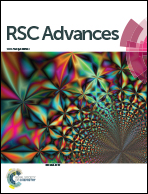Tailoring the structure and gas permeation properties of silica membranes via binary metal oxides doping†
Abstract
The sol–gel method was employed for the synthesis of binary X–Co (X: Mn, Cr) oxide-doped silica membranes with different X/Co molar ratios (X/Co: 0.1, 0.3, 0.9). Single-gas permeation tests were performed at 200 °C to determine the effect of the binary oxide composition on the amorphous silica network. The X-ray diffraction (XRD), X-ray Photoelectron Spectroscopy (XPS) and Transmission Electron Microscopy (TEM) indicated the presence of smaller MnxCo3−xO4 and CrxCo3−xO4 oxide nanocrystals in the silica matrix in addition to amorphous Co, Mn and Cr species. The H2/N2 permeance ratio decreased from (126.3 ± 9) to (10.7 ± 2) with an increase in X/Co molar ratio from 0.1 to 0.9 due to the formation of larger pores. However, the binary Co–X oxide-doped silica membrane with the lowest X content showed a H2/N2 permeance ratio, (126.3 ± 9), higher than that, (63.6 ± 6), of the single cobalt oxide silica membrane. Based on FTIR analysis, it was found that the densification of the membrane at low X content resulted from the formation of silica structures with narrowed siloxane rings. In contrast, the enlargement of siloxane rings due to favorable condensation reactions occurred at high X content.


 Please wait while we load your content...
Please wait while we load your content...